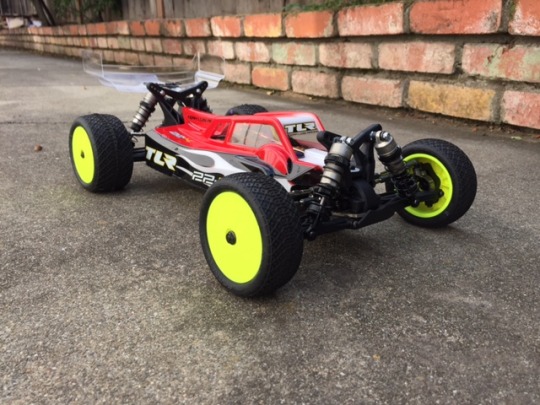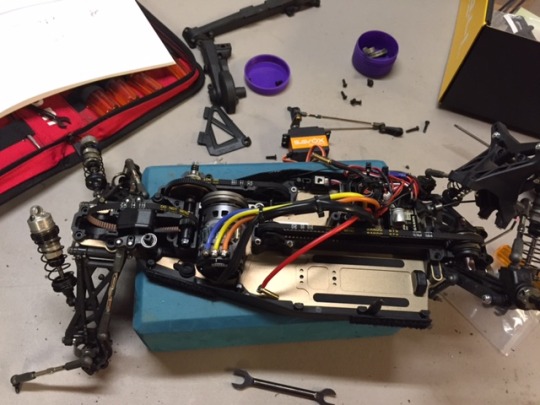
I’ve been thinking about buying a 4WD buggy for a while now, and got the chance to pick up a TLR 22-4 2.0. Honestly, I was looking for a few things in a buggy – high performance, low price, and belt drive was something I was interested in because I’ve never owned a belt drive RC car before. I was also looking for a car with a unique design and something fun to build. The 22-4 2.0 met all of those requirements, and after building it and driving it for a while, here’s my review.
Overview:
The 22-4 2.0 is one of the few belt driven 4WD buggies on the market today. Most cars have gone to shaft drive, and the belt drive is a bit of a throwback harkening to the Losi XX-4 and XXX-4 days.
It’s also a small evolution on the original 22-4 (1.0), and basically includes all of the option parts TLR found that made the original buggy better. These include 12.5 degree caster blocks, a shortened chassis, cab forward body, shorty battery placement, CVD axles, 22 rear hubs and rear swaybar. The other notable improvement is the addition of gear diffs. TLR also redesigned the front end for more durability and the chassis for less flex.
Build: 8
I found the build to be relatively straightforward for such a complex vehicle. The rolling chassis took me about 8 hours to build, and the electronics/tires/body took a few more hours.
The manual is clear and fairly accurate. There were a couple of minor errors (one screw was missing in the diagram for step E-5 and one of the screw measurements was wrong (12mm instead of 10mm)), but overall I found it pretty clear.
There is a gear diff build video Frank Root has on the TLR Facebook page that I highly recommend you watch. A couple of tips that will help is to always threadlock all metal to metal screws, and to clean off any black oxide steel parts with motor spray before you thread/loctite them in. These include the set screws used in the outdrives and the gear diffs. Doing these two things will greatly improve the likelihood everything stays together.
The 22-4 2.0 is a complex design, but the plastic and metal pieces all fit together with quite tight tolerances. I’m pretty impressed with how the parts fit together so well, even though they are a bit of a jigsaw puzzle. The manufacturing on these parts is top notch.
In terms of packaging, you have bags within bags within bags, but the steps flow nicely from A-G and there was no need to hunt through various bags to find parts – you got what you needed in each bag, and when you ran out of parts you were done with that step.
It would have been nice to get a few extra E-clips for the shocks or other small parts that are easy to lose. The only extra parts were a couple of the jackshaft clips. Not a big deal, but be sure you don’t lose anything while doing the build.
I would not recommend this buggy as your first kit, however. It assumes you understand a few things that experienced RC drivers will know and doesn’t go into detail about things like how to set your slipper, or how to bleed your emulsion shocks.
Design: 3
Let’s face it – the 22-4 2.0 is a complicated design. There’s no way around it. It’s clear they made a couple of basic architectural decisions – belt drive down the middle, saddle packs in the rear, and the rest of the design flowed around these decisions.
Once the basic battery layout and rear belt drive was decided upon, they had to put the motor in the middle, had to use a 3rd belt to connect the front and rear belt drives, and had to go with two jackshafts to connect the belts.
With the 3 belt system, that meant everything else (shock towers, steering rack, servo) had to be laid out around, on top, and in the case of the steering, through these belts. This makes for a very cumbersome layout to get to individual parts (diffs, belts, spur gear, bearings), and maintenance on this vehicle is no simple task.
A lot of the parts are interconnected – to remove the center belt cover, you have to remove the front cover and the servo. To remove the front cover, you have to remove the front shock tower.
Removing the rear cover requires removing the rear shock tower (4 bolts on the bottom and 3 on the top). But oh, if you want to replace the belt, you need to yank the rear jackshaft, which requires removing the center belt cover. Which requires removing…
So not an elegant design. It may actually be the most complicated 1/10 scale RC car on the market today.
The front belt is non-adjustable, and will need replacing when it becomes too loose. The center and rear belts are adjustable, but they are inter-related, meaning when you tighten the center belt, you also loosen the rear belt. So you have to be sure to compensate when you make changes.
On the plus side, the motor mount uses a neat eccentric motor plate that lets you adjust gear mesh just by rotating the plate. Quite a clever design that I think is brought over from the XXX-4.
Performance: 9
Wow, does this buggy drive well. Once you’re done with the build and get it out on the track, it makes you forget the complexity of the car, because it all just works together in perfect harmony.
The out of the box kit setup is spot-on, and basically perfect in my opinion. It’s the best out of the box setup I’ve ever driven of any car, I literally felt no need to change anything. It drives very smoothly, steers well, has tons of traction, brakes hard, rotates well, jumps well and lands well. The shocks also have that typical TLR smoothness and plushness that are among the best in the RC world.
It has a tiny bit of nosedive, pretty typical of most 4WD vehicles. The only 4WD buggy I’ve driven that had no nosedive at all was the Kyosho ZX-6, but the 22-4 2.0 has a minimal amount of nosedive and is better than most.
About the only thing I can say negatively about the driving performance of this vehicle is that it doesn’t handle bad landings particularly well. If you land poorly on one corner/wheel, it has a tendency to flip/roll. I’m not sure why this is or if it’s related to the belt drive system, but it’s there.
In addition to driving well, it is also very quiet. The belts are by nature quiet, but the entire drivetrain is enclosed which keeps out dirt and noise. The spur and pinion are also enclosed contributing to the silent running of this vehicle.
One thing to watch out for is that the belts take a while to break-in. There is a lot of drag on the drivetrain before they break-in, which means your motor will run very hot for the first 15-20 packs. I used an old 13.5t Team Powers motor I had lying around, and it would get up to 205 degrees for the first couple of dozen packs. I recommend you let the motor fully cool down between packs, and maybe even gear down or run a fan. You can also run the rear belt on the loose side (I went to the A-insert forward) for the first few packs. The center belt is already on the loosest setting, per kit build.
Durability: 5
I haven’t broken any parts on my buggy yet, the durability actually seems very good so far. TLR uses a lot of aluminum in critical crash areas. There are reports that hard frontal collisions can break the front pivot brace, so that is a part you will want to stock up on, but I haven’t broken it yet. I am only running a 13.5t motor.
But the reason I give the durability a middling score is because the TLR plastics are down compared to other manufacturers. They used to be average in terms of wear and slop in my opinion, but the competitors have improved the wear of their plastics the last few years, and I would rate TLR plastics as definitely below average now.
XRAY plastics are amazing, Kyosho plastics are solid, and even Associated plastics are very good now. You will want to replace the arms and pivot block periodically for optimum precision.
I ended up replacing the front plastic pivot brace after 40-50 packs even though it hadn’t broken, because there was a fair amount of slop preventing it from solidly keying into the chassis.
There is a fair amount of wear on the rear hinge pin brace and the end of the chassis. I’m not sure if this will be a long term problem, but it’s quite a bit of wear for only a month of use.
Value: 10
There’s no doubt the 22-4 2.0 is the best-valued 4WD race buggy on the market today. It includes basically everything you could want in the box. The only optional part I added was aluminum rear hexes, and even that is not really necessary.
You get the full kit, a set of wheels, tons of aluminum parts (caster blocks, camber blocks, machined diffs, machined shocks), all fluids and greases, a precut body, and gear diffs for basically the lowest price on the market. The 22-4 2.0 sells for $399.99, while every other race-level buggy kit is over $400 or even $500.
It’s an outstanding value, and considering it’s also one of the highest performing wheelers, you get that rare combination of extremely high value and performance.
Support: 8
The 22-4 is not a super popular vehicle, but TLR will post setup sheets from time to time and their staff is always available on social media and online. They definitely are responsive to issues (the first batch of kits had CVD problems that they sent free parts out for), so I have to give them props for the great service they provide.
Dislikes:
Really the main complaint with the 22-4 2.0 is the difficulty with which it is to maintain and service the drivetrain. Within the first couple of sessions, I wanted to inspect the belts for tension, and getting to the belts entailed basically tearing the whole car apart.
A well-known sight to 22-4 owners:

If you don’t like working on your car, then this is not the right vehicle for you. A power screwdriver is a must, as well as a good parts tray organizer.
There are still some SAE nuts and bolts on this vehicle, which is a bit of a letdown. Some of the bearings are also SAE, and you need a 0.05″ hex driver. Not a big deal, just something to be aware of. One day TLR will go fully metric, and the world will rejoice!
The front wheel nuts are really slim, they only engage on 3 or 4 threads of the front axle. I replaced them with some longer ones because my hex driver barely grabbed onto the nut.
Conclusion:
The TLR 22-4 2.0 is an amazing buggy. It’s an intricate design requiring you to keep on top of maintenance, but if you’re willing to deal with the pain, you get an outstanding vehicle that drives at least as well, if not better than its competitors. And at a lower price.
It’s not unlike owning an Italian sports car or dating a supermodel. Yeah, there are times you want to bang your head against the wall, but once you take it for a drive, you forget all about it and enjoy the ride.
No comments:
Post a Comment
Note: Only a member of this blog may post a comment.